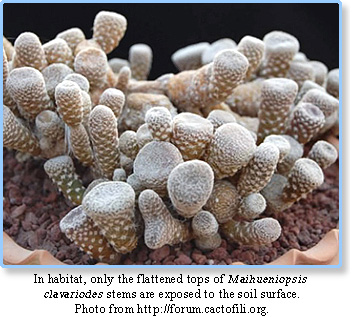– Maihueniopsis clavarioides (2018)
 By Pat Mahon (October 2018)
By Pat Mahon (October 2018)
Some of the strangest plants in the cacti family seem to belong to the curious genus Maihueniopsis. Most commonly referred to and formerly classified as Puna, they are some of the most diverse cacti of the opuntiads. The genus Maihueniopsis is closely allied to and sometimes formerly classified as Opuntia, Tephrocactus and Austrocylindropuntia.
All of the Maihueniopsis species hail from harsh environments in South America. These environments are unforgiving and get very little rainfall. For the cactus of the month, Maihueniopsis clavarioides was chosen not only for its unique beauty, but because of its strong presence in the hobby — and maybe its lack of sharp spines.
Maihueniopsis clavariodes etymology is adapted from the language of the Mapuche, indigenous inhabitants of Chile and Argentina. Their word “Maihuen” translates to “woman,” and from the ancient Greeks, “-opsis” means “appearance.” “Clavarioides” derives from “Clavaria,” a genus of coral-like fungi, and “-oides” means “likeness.” Maihueniopsis plants shed their leaves, while the closely allied Maihuenia species retain their leaves.
A Patagonian cactus, Maihueniopsis clavariodes is found among montane shrubs and grasses in high-elevation Argentina at 2,000 to 3,000 meters above sea level. Restricted to the provinces of San Juan and Mendoza, it faces relatively little threat in habitat from overcollection or human encroachment. It also is found in barren areas where no other plant species can survive.
 In habitat, it may mimic rocks, becoming a cryptic cactus species. M. clavariodes has developed a unique adaptation, in which the seed germinates a long root before sending up a stem. The root eventually grows into a tuber, which sends up a long, tubelike stem to the surface. Only the tops of these stems are exposed to the surface, and they flatten out. During the end of summer, the tubers and stem contract, and the vegetative parts of the plants may separate and wither away. The tuber will send up another growth and begin the process again after winter.
In habitat, it may mimic rocks, becoming a cryptic cactus species. M. clavariodes has developed a unique adaptation, in which the seed germinates a long root before sending up a stem. The root eventually grows into a tuber, which sends up a long, tubelike stem to the surface. Only the tops of these stems are exposed to the surface, and they flatten out. During the end of summer, the tubers and stem contract, and the vegetative parts of the plants may separate and wither away. The tuber will send up another growth and begin the process again after winter.
This species secretly makes leaves amongst the wool and pectinate spines! The very minute leaves are red in color and shed while new growth appears. The spines are not “spiny” and do not hurt, and unlike Maihueniopsis’ relative Opuntia, no glochids hide on the areoles. Flowers have a typical opuntioid shape and appearance with narrowed sepals and slightly spatulate petals. The fruit is unusual, in that it does not open up normally, and only one seed is produced. Most of the fruits I have witnessed need some sort of mechanical help to open.
M. clavariodes is characterized by its tuberous root system, which is key to understanding the cultivation of this species. Many of us have tried to grow the plants, only to have them shrivel and die due to lack of water, or shrivel and die because they were watered. Very picky? Perhaps not. Here are some growing suggestions.
1. Substrate. Ensure the substrate retains as little water as possible. This species has adapted to extreme conditions and developed a technique to store and utilize water efficiently. It needs a coarse, fast-draining substrate in a fairly deep pot.
2. Watering. When the plant is actively growing from spring to summer, ensure it gets adequate water. I have not seen a benefit of fertigation. When in a fast-draining substrate, the chance of overwatering and rot is lessened. In winter, the plant will require cooler temperatures and no water! Only lightly water to maintain stems that shrivel considerably. Cooler temperatures during dormancy may help induce flowering the following year.
3. Lighting. M. clavariodes can stand full sun, but ensure the plants do not get extreme heat! They are high-elevation inhabitants, where temperatures are not always scorching hot. If possible, give the plants about six hours of full sun daily. They have survived in strong indirect light ranging from six to eight hours per day.
This species does well while grafted on Opuntia rootstock, exceeding the growth rates of M. clavarioides on its own roots. Do not be discouraged by the slow growth rate of this species. You may find its beauty in the moment is defined by the intriguing and irregular stem production, rather than excessive growth.
Even the most novice of growers are encouraged to give Maihueniopsis clavariodes, one of the most alienlike species of cacti, a try. You may find it to be a rewarding success story!
